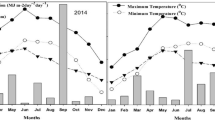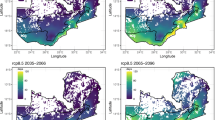Abstract
The potential impacts of climate change on the phenology and yield of two maize varieties in Greece were studied. Three sites representing the central and northern agricultural regions were selected: Karditsa, Naoussa and Xanthi. The CERES-Maize model, embedded in the Decision Support System for Agrotechnology Transfer (DSSAT 3.0), was used for the crop simulations, with current and possible future management practices. Equilibrium doubled CO2 climate change scenarios were derived from the GISS, GFDL, and UKMO general circulation models (GCMs); a transient scenario was developed from the GISS GCM transient run A. These scenarios predict consistent increases in air temperature, small increases in solar radiation and precipitation changes that vary considerably over the study regions in Greece. Physiological effects of CO2 on crop growth and yield were simulated. Under present management practices, the climate change scenarios generally resulted in decreases in maize yield due to reduced duration of the growing period at all sites. Adaptation analyses showed that mitigation of climate change effects may be achieved through earlier sowing dates and the use of new maize varieties. Varieties with higher kernel-filling rates, currently restricted to the central regions, could be extended to the northern regions of Greece. In the central regions, new maize varieties with longer grain-filling periods might be needed.
Similar content being viewed by others
References
Cock, B. and AllenJr., L. H.: 1985, Crop responses to elevated carbon dioxide concentrations. In B. R.Strain and J. D.Cure (eds). Direct Effects of Increasing Carbon Dioxide on Vegetation. U.S. Department of Energy. DOE/ER-0238 Washington, D.C. pp. 33–97.
Basci, Z., Thornton, P. K. and Dent, J. B.: 1991. Impacts of Future Climate Change on Hungarian Crop Production: An Application of Crop Growth Simulation Models. Agr. Syst. 37, 435–450.
Hansen, J., Russel, G., Rind, D., Stone, P., Lacis, A., Lebedeff, S., Ruedy, R.,and Travis, L.: 1983. Efficient three dimensional global models for climate studies: Models I and II. Monthly Weather Review 111(4), 609–662.
Hansen, J., Fung, I., Lacis, A., Rind, D., Russel, G., Lebedeff, S., Ruedy, R.,and Stone, P.: 1988. Global climate changes as forecast by the GISS 3-D model. Journal of Geophysical Research 93, 9341–9364.
International Benchmark Sites Network for Agrotechnology Transfer (IBSNAT).: 1989. Decision Support System for Agrothechnology Transfer Version 2.1 (DSSAT 2.1). Dept. of Agronomy and Soil Science. College of tropical Agriculture and Human Resources. University of Hawaii. Honolulu.
IPCC. Climate Change, 1995: Impacts, Adaptations and Mitigations of Climate Change: Scientific-Technical Analyses, 1996. R. T.Watson, M. C.Zinyowera, R. H.Moss (Eds), Cambridge University Press, Cambridge, 890 pp.
Jones, C. A. and Kiniry, J. R.: 1986. CERES-Maize: A simulation Model of Maize Growth and Development. Texas A&M Press, College station.
Jones, H. G.: 1992. Plants and Microclimate. A Quantitative Approach to Environmental Plant Physiology, Second Edition, Cambridge University Press, Cambridge, U.K.
Manabe, S. and Wetherland, R. T.: 1987. Large-scale changes in soil wetness induced by an increase in CO2, Journal of Atmospheric Science, 44 1211–1235.
Maytin, E. C., Achevedo, M. F., Jaimez, R., Andressem, R., Harwell, M. A., Robock, A., andAzocar, A.: 1995. Potential effects of Global Climate Change on the Phenology and Yield of Maize in Venezuela. Climatic Change 29, 189–211.
Mearns, L. O. and Rosenzweig, C.: 1996. Formulation of climate change scenarios incorporating changes in daily climate variability and application to crop models, in: Assessing Climate Change: The story of the Model Evaluation Consortium for Climate Assessment. Chap. 15. Howe, W., and Henderson-Sellers, A. (Eds.). Academic Publishers, in press.
National Agricultural Research Foundation. (NAGREF): 1995. Meteorological data files Pomology Institute at Naoussa Greece, unpublished.
Parry, M. L., Carter, T. R., and Konijn, N. T. (eds).: 1988. The Impact of Climatic Variation on Agriculture. Vol. 1. Assessments in Cool Temperate and Cold Regions. Vol. 2. Assessments in Semi-arid Regions. Kluwer. Dordrecht. Netherlands.
Peart, R. M., Jones, J. W., Curry, R. B., Boote, K., and AllenJr., L. H.: 1989. Impact ofclimate change on crop yield in the southeastern U.S.A. In J. B.Smith and D. A.Tirpak (eds). The Potential Effects of Global Climate Change on the United States. Report to Congress. U.S. Environmental Protection Agency. EPA-230-05-89-050. Appendix C. Washington, D.C.
Ritchie, J. T., Singh, U., Godwin, D., and Hunt, L.: 1989. A User's Guide to CERES-Maize v.2.10. International Fertilizer Development Center, Muscle Shoals.
Rosenberg, N. J., and Crosson, P. R.: 1991. Processes for Identifying Regional Influences of and Responses to Increasing Atmospheric CO2 and Climate Change: The MINK Project. An Overview. Resources for the Future. Dept. of Energy. DOE/RL/01830t-H5. Washington, D.C. 35 pp.
Rosenzweig, C.: 1990. Crop response to Climate Change in Southern Great Plains: A simulation study. Prof. Geog. 42, 20–39.
Rosenzweig, C., and Parry, M. L.: 1994. Potential Impact of climate change on world food supply. Nature 367, 133–138.
Rosenzweig, C., and Iglesias, A. (eds).: 1994, Implications of Climate Change for International Agriculture: Crop modeling study. USEPA. Washington DC.
Rosenzweig, C., Allen, Jr., L. H., Harper, L. A., Hollinger, S. E., and. Jones, J. W. (eds).: 1995. Climate Change and Agriculture: Analysis of Potential International Impacts. ASA Special Publication No 59, Madison, WI.
Rosenzweig, C. and Tubiello, F.N.: 1996. Effects of Changes in Minimum and Maximum Temperature on Wheat Yields in the Central U.S.: A Simulation Study. Agric. For. Meteorol., in press.
Tobacco Research Organization (TRO.).: 1995. Meteorological data files. Dept. of Tobacco Research Organization Greece, unpublished.
Tsuji, G. Y., Uehara, G., and Balas, S. (eds).: 1994. Decision Support System for Agrotechnology Transfer Version 3.0 (DSSAT V3.0). International Benchmark Sites Network for Agrotechnology Transfer Project (IBSNAT). University of Hawaii, Honolulu, Hawaii.
Wilson, C. A., and Mitchell, J. F. B.: 1987. A Doubled CO2 Climate Sensitivity Experiment with a Global Climate Model Including a Simple Ocean. J. Geophys. Res. 92, 315–343.
Wolf, J., and VanDieppen, C. A.: 1995. Effects of Climate Change on Grain Maize Yield Potential in the European Community. Climatic Change 29, 299–331.
Author information
Authors and Affiliations
Rights and permissions
About this article
Cite this article
Kapetanaki, G., Rosenzweig, C. Impact of climate change on maize yield in central and northern Greece: A simulation study with CERES-Maize. Mitig Adapt Strat Glob Change 1, 251–271 (1997). https://doi.org/10.1007/BF00517806
Received:
Accepted:
Issue Date:
DOI: https://doi.org/10.1007/BF00517806




